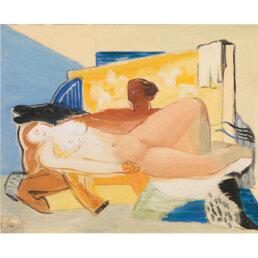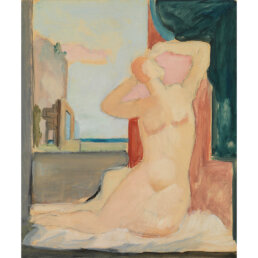Gerasimos Steris
(1898-1987)
Gerasimos Steris is considered to be one of the pioneers of Greek modernism, through his thematic yet plastic freedom of his paintings, the symbolic extensions and references to metaphysical art, he managed to create a split in the interwar years in Greece. His dialogue of classical aesthetics presented through objectivity and mythological excess, Steris manages to express the magic realism of a mythological world, by in some cases connecting Greek and European Art.
Full CV
Gerassimos Steris was born in Kefalonia, Greece in 1898. During his early years his family was between Egypt and Italy. In 1915, he enrolled at The School of Fine Arts, in Athens and attended classes until 1917, having as mentors Dimitrios Geraniotis and Giorgos Jakovides.
From 1919 to 1926, he travelled extensively in Europe while living in Paris, where he continued his studies at the Academie Julian, while mingling in the city’s artistic circles and befriends Picasso, Derrain and many more. Between August and October 1926, he comes back to Greece, whereby a single painting representation he receives his diploma from the School of Fine Arts, as well as a three-year University scholarship from the Voltos Fund. Moving back to Paris by the end of that year he studies murals and interior design, at the Ecole des Beaux Arts.
By 1927, he studies and works at his own studio, he met the gallery owner Manolis Segredakis, who became the prime supported of his work. He also collaborated with professor Beaudouin, decorating public buildings.
After returning to Greece in 1931, he held his first solo exhibition, which left critics divided. A negative review by Zacharias Papantoniou, was reason for seventeen critics to support the exhibition. The article was called “An Exhibition’s 18 Critique Articles”, some of the critics included Spyros Melas, Stratis Doukas and Christos Karouzos. A manifesto of modernism in Greece. Such event cut off Steris fromn pursuing his career in Greece. In September 1933, he arrives in Paris after travelling in Italy, Lake Como, and Alexandria Egypt where he most likely help an exhibition.
In 1937, he moves to the United States hosting his first solo show there in New York. From then on, he worked in Hollywood for big American film-making companies, for the design of publications and posters, and travelled through the continent under the name George de Steris. A couple of years later he decorated with four large murals, the Greek Pavillion at the New York World Fair, depicting Greece’s history. Ten years later, he became an American citizen, and changed his name to Guelfo Ammon d’Este.
Between 1950 and 1965 Steris was teaching painting, while in this period he painted frescos for the Orthodox Cathedral of NY and the Holy Trinity of Massachusetts. He then taught at the Traphagen School.
He decided to move with his wife to Nice, France in 1980, where they lived until 1985, where he returned to New York and passed away two years later.
Even though Greece lost track of Steris and his presence from the country since early ’50s, it did not stop him from holding many solo exhibitions, such as, “Nees Morfes” in 1969, or Macedonian Art Society in 1970. In 1980, the Sculpture Gallery of Munich presented his work, as well as the National Gallery of Athens in ’82. His work can be found in the National Gallery of Greece, The Municipal Gallery of Athens, The Averoff Gallery, The National Bank of Greece and many other public and private collections.
Full CV
Museums and Public Collections
Learn More
View Less


